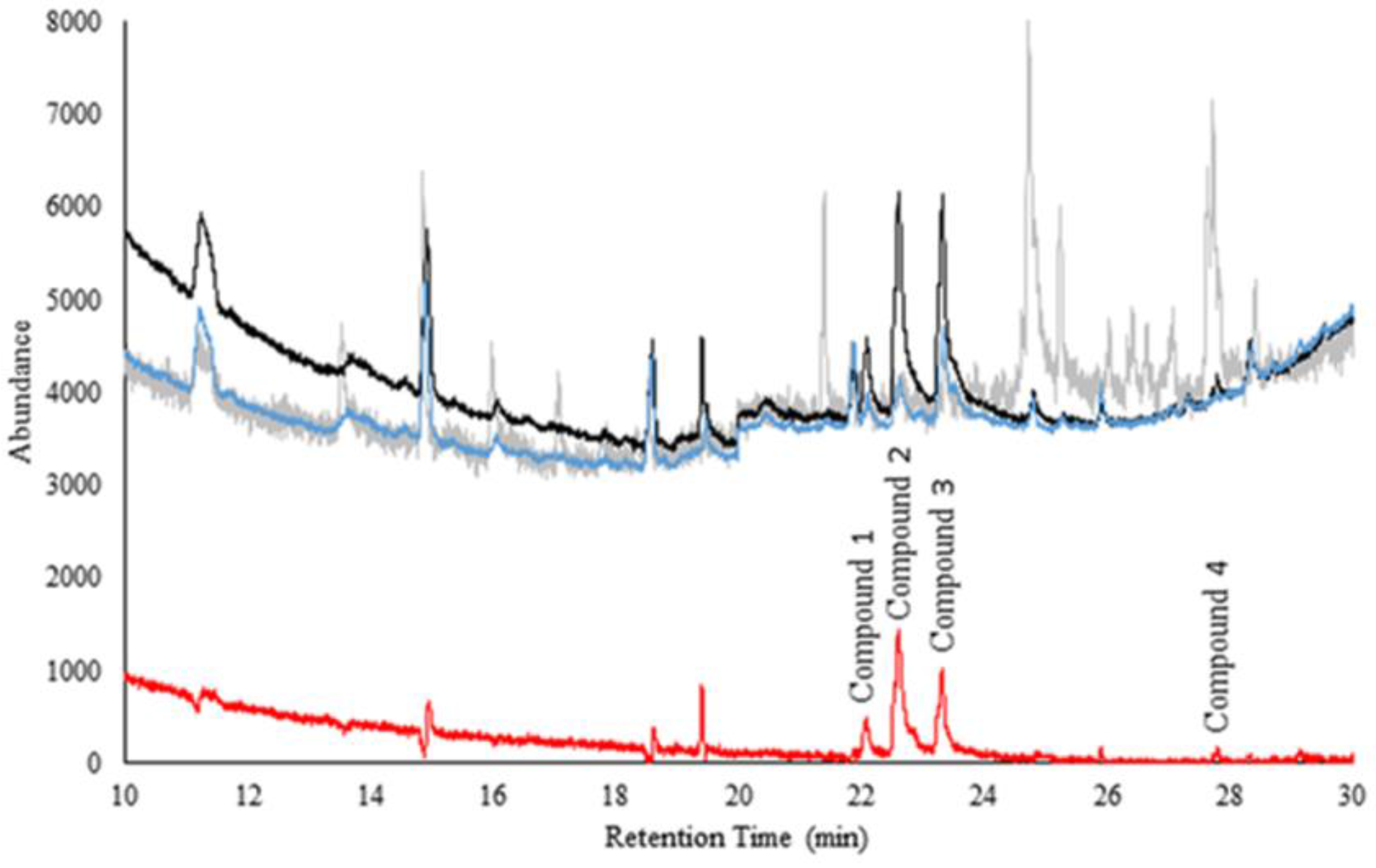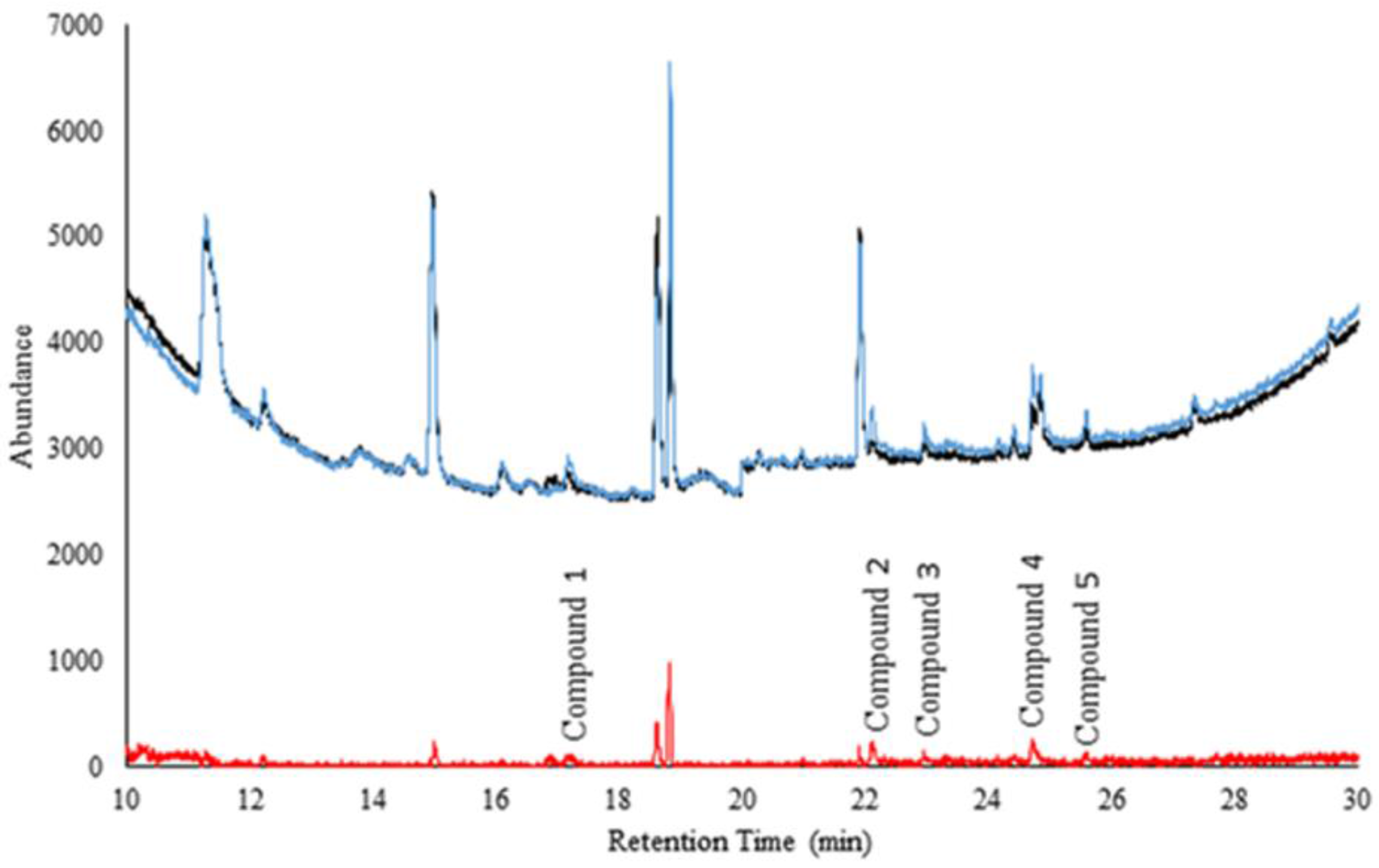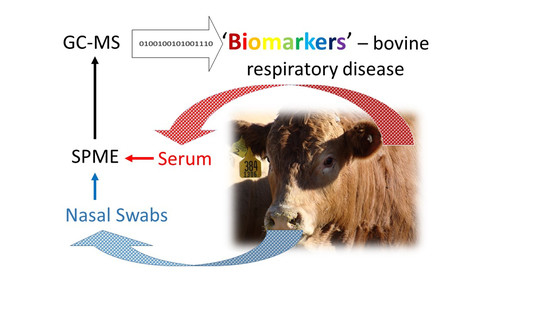Detection of Volatile Compounds Emitted from Nasal Secretions and Serum: Towards Non-Invasive Identification of Diseased Cattle Biomarkers
Abstract
:1. Introduction
2. Materials and Methods
2.1. Sample Collection
2.2. Volatile Organic Compounds
2.3. Statistical Analyses
3. Results
3.1. Cattle Nasal Swabs
3.2. Cattle Serum
4. Discussion
5. Conclusions
Supplementary Materials
Acknowledgments
Author Contributions
Conflicts of Interest
References
- Wang, A.; Wang, C.P.; Tu, M.; Wong, D.T. Oral Biofluid Biomarker Research: Current Status and Emerging Frontiers. Diagnostics 2016, 6, 45. [Google Scholar] [CrossRef] [PubMed]
- Majem, B.; Rigau, M.; Reventós, J.; Wong, D.T. Non-Coding RNAs in Saliva: Emerging Biomarkers for Molecular Diagnostics. Int. J. Mol. Sci. 2015, 16, 8676–8698. [Google Scholar] [CrossRef] [PubMed]
- Rapado-González, Ó.; Majem, B.; Muinelo-Romay, L.; López-López, R.; Suarez-Cunqueiro, M.M. Cancer Salivary Biomarkers for Tumours Distant to the Oral Cavity. Int. J. Mol. Sci. 2016, 17, 1531. [Google Scholar] [CrossRef] [PubMed]
- Spinhirne, P.J.; Koziel, J.A.; Chirase, N. Sampling and analysis of VOCs in bovine breath using solid-phase microextraction and gas chromatography-mass spectrometry. J. Chrom. A 2004, 1025, 63–69. [Google Scholar] [CrossRef]
- Spinhirne, P.J.; Koziel, J.A.; Chirase, N. A device for noninvasive on-site sampling of cattle breath with solid phase microextraction. Biosyst. Eng. 2003, 84, 239–246. [Google Scholar] [CrossRef]
- Ellis, C.K.; Stahl, R.S.; Nol, P.; Waters, W.R.; Palmer, M.V.; Rhyan, J.C.; VerCauteren, K.C.; McCollum, M.; Salman, M.D. A Pilot Study Exploring the Use of Breath Analysis to Differentiate Healthy Cattle from Cattle Experimentally Infected with Mycobacterium bovis. PLoS ONE 2014, 9, e89280. [Google Scholar] [CrossRef] [PubMed]
- Ellis, C.K.; Rice, S.; Maurer, D.; Stahl, R.; Waters, W.R.; Palmer, M.V.; Nol, P.; Rhyan, J.C.; VerCauteren, K.C.; Koziel, J.A. Use of fecal volatile organic compound analysis to discriminate between non-vaccinated and BCG—Vaccinated cattle prior to and after Mycobacterium bovis challenge. PLoS ONE 2017, 12, e0179914. [Google Scholar] [CrossRef] [PubMed]
- Maurer, D.; Ellis, C.; Thacker, T.; Rice, S.; Koziel, J.A.; VerCauteren, K.C.; Nol, P. Screening of microbial volatile organic compounds for detection of disease in cattle: Development of lab-scale method. Sci. Rep. 2018. under review. [Google Scholar]
- Smith, R.A. Factors Influencing Bovine Respiratory Disease in Stocker and Feedlot Cattle. In Proceedings of the American Association of Bovine Practitioners Annual Meeting, Albuquerque, NM, USA, 19–21 August 2010; Volume 43, pp. 10–15. [Google Scholar]
- Griffin, D.D. The monster we don’t see: Subclinical BRD in beef cattle. Anim. Health Res. Rev. 2014, 15, 138–141. [Google Scholar] [CrossRef] [PubMed]
- Busby, D. Tri-County Steer Carcass Futurity Data. In Proceedings of the American Association of Bovine Practitioners Annual Meeting, Albuquerque, NM, USA, 19–21 August 2010; Volume 43, pp. 71–81. [Google Scholar]
- Reinhardt, C.; Thomson, D.U. Nutrition of Newly Received Feedlot Cattle. Vet. Clin. North Am. Food Anim. Pract. 2015, 31, 283–294. [Google Scholar] [CrossRef] [PubMed]
- Goldansaz, S.A.; Guo, A.C.; Sajed, T.; Steele, M.A.; Plastow, G.S.; Wishart, D.S. Livestock metabolomics and the livestock metabolome: A systemic review. PLoS ONE 2017, 12, e0177675. [Google Scholar] [CrossRef] [PubMed]
- Lamy, E.; Mau, M. Saliva proteomics as an emerging, non-invasive tool to study livestock physiology, nutrition and diseases. J. Proteom. 2012, 75, 4251–4258. [Google Scholar] [CrossRef] [PubMed]
- Bertram, H.C.; Yde, C.C.; Zhang, X.; Zhang, X.; Kristensen, N.B. Effect of dietary nitrogen content on the urine metabolite profile of dairy cows assessed by nuclear magnetic resonance (NMR)-based metabolomics. J. Agric. Food Chem. 2011, 59, 12499–12505. [Google Scholar] [CrossRef] [PubMed]
- Hailemariam, D.; Mandal, R.; Saleem, F.; Dunn, S.M.; Wishart, D.S.; Ametaj, B.N. Identification of predictive biomarkers of disease state in transition dairy cows. J. Dairy Sci. 2014, 97, 2680–2693. [Google Scholar] [CrossRef] [PubMed]
- Zhao, S.; Zhao, J.; Bu, D.; Sun, P.; Wang, J.; Dong, Z. Metabolomics analysis reveals large effect of roughage types on rumen microbial metabolic profile in dairy cows. Lett. Appl. Microbiol. 2014, 59, 79–85. [Google Scholar] [CrossRef] [PubMed]
- Cai, L.; Koziel, J.A.; Davis, J.; Lo, Y.C.; Xin, H. Characterization of VOCs and odors by in vivo sampling of beef cattle rumen gas using SPME and GC-MS-olfactometry. Anal. Bioanal. Chem. 2006, 386, 1791–1802. [Google Scholar] [CrossRef] [PubMed]
- Spinhirne, J.P.; Koziel, J.A.; Chirase, N. Characterizing volatile fatty acids and other gases in a rumen closed in vitro fermentation system using solid phase microextraction. Trans. ASABE 2003, 46, 585–588. [Google Scholar] [CrossRef]
- Basoglu, A.; Baspinar, N.; Tenori, L.; Vignoli, A.; Yildiz, R. Plasma metabolomics in calves with acute bronchopneumonia. Metabolomics 2016, 12, 128. [Google Scholar] [CrossRef]
- Soso, S.B.; Koziel, J.A. Analysis of odorants in marking fluid of Siberian tiger (Panthera tigris altaica) using simultaneous sensory and chemical analysis with headspace solid-phase microextraction and multidimensional gas chromatography-mass spectrometry-olfactometry. Molecules 2016, 21, 834. [Google Scholar] [CrossRef] [PubMed]
- Soso, S.B.; Koziel, J.A. Characterizing the scent and chemical composition of Panthera leo marking fluid using solid-phase microextraction and multidimensional gas chromatography-mass spectrometry-olfactometry. Sci. Rep. 2017, 7, 5137. [Google Scholar] [CrossRef] [PubMed]
- Cai, L.; Koziel, J.A.; O’Neal, M. Studying plant—Insect interactions with solid phase microextraction: Screening for airborne volatile emissions of soybeans to the soybean aphid, Aphis glycines Matsumura (Hemiptera: Aphididae). Chromatography 2015, 2, 265–276. [Google Scholar] [CrossRef]
- Wishart, D.S.; Tzur, D.; Knox, C.; Eisner, R.; Guo, A.C.; Young, N.; Cheng, D.; Jewell, K.; Arndt, D.; Sawhney, S.; et al. HMDB: The Human Metabolome Database. Nucleic Acids Res. 2007, 35, 17202168. [Google Scholar] [CrossRef] [PubMed]
- Wishart, D.S.; Knox, C.; Guo, A.C.; Eisner, R.; Young, N.; Gautam, B.; Hau, D.D.; Psychogios, N.; Dong, E.; Bouatra, S.; et al. HMDB: A knowledgebase for the human metabolome. Nucleic Acids Res. 2009, 37, 18953024. [Google Scholar] [CrossRef] [PubMed]
- Wishart, D.S.; Jewison, T.; Guo, A.C.; Wilson, M.; Knox, C.; Liu, Y.; Djoumbou, Y.; Mandal, R.; Aziat, F.; Dong, E.; et al. HMDB 3.0—The Human Metabolome Database in 2013. Nucleic Acids Res. 2013, 41, 23161693. [Google Scholar] [CrossRef] [PubMed]
- Wolff, M.S.; Teitelbaum, S.L.; Windham, G.; Pinney, S.M.; Britton, J.A.; Chelimo, C.; Godbold, J.; Biro, F.; Kushi, L.H.; Pfeiffer, C.M.; et al. Pilot study of urinary biomarkers of phytoestrogens, phthalates, and phenols in girls. Environ. Health Perspect. 2007, 115, 116–121. [Google Scholar] [CrossRef] [PubMed]
- National Center for Biotechnology Information. PubChem Compound Database. CID 7583. Available online: https://pubchem.ncbi.nlm.nih.gov/ (accessed on 18 February 2018).
- Muniasamy, S.; Selvam, R.M.; Rajanarayanan, S.; Saravanakumar, V.R.; Archunan, G. P-cresol and oleic acid as reliable biomarkers of estrus: Evidence from synchronized Murrah buffaloes. Iran. J. Vet. Res. 2017, 18, 124–127. [Google Scholar] [PubMed]


| Compound # | Preliminary ID | Column Retention Time (min) | Sick Cattle Peak Area (a.u.) | Healthy Cattle Peak Area (a.u.) | Confirmed RT with standard | Spectral Match (%) | Top Five Ion Distribution, Ion (%) |
|---|---|---|---|---|---|---|---|
| Compound 1 | Phenol | 22.10 | 91,300 (±44,100) | 145,000 (±89,700) | yes | 62 | 94(100), 65(37), 66(33), 39(31), 40(21) |
| Compound 2 | Benzothiazole | 22.61 | 120,000 (±121,000) | 378,000 (±157,000) | no | 78 | 135(100), 108(32), 69(17), 44(10), 63(10) |
| Compound 3 | p-Cresol | 23.3 | 190,000 (±128,000) | 340,000 (±187,000) | yes | 57 | 108(100), 107(89), 77(59), 79(30), 41(23) |
| Compound 4 | 5-Octadecenal | 27.80 | 33,100 (±39,900) | 64,100 (±90,400) | no | 56 | 55(100), 41(46), 73(44), 97(37), 84(35) |
| Compound # | Preliminary ID | Column Retention Time (min) | Sick Cattle Peak Area (a.u.) | Healthy Cattle Peak Area (a.u.) | Confirmed RT with Standard | Spectral Match (%) | Top Five Ion Distribution, Ion (%) |
|---|---|---|---|---|---|---|---|
| Compound 1 | 9-Hexyl-heptadecane, | 17.15 | 40,200 (±44,200) | 25,400 (±22,000) | no | 49 | 57(100), 43(89), 45(69), 71(36), 41(31) |
| Compound 2 | Phenol | 22.10 | 63,000 (±52,500) | 38,400 (±32,900) | yes | 49 | 94(100), 65(31), 66(27), 39(23), 40(22) |
| Compound 3 | Isolongifolene | 23.05 | 53,400 (±38,000) | 36,800 (±27,300) | no | 50 | 159(100), 55(41), 145(34), 202(29), 43(27) |
| Compound 4 | Diphenyl ether | 24.72 | 71,800 (±81,300) | 31,400 (±42,900) | no | 57 | 170(100), 141(63), 51(52), 77(45), 44(44) |
| Compound 5 | TMC 1 | 25.60 | 43,700 (±27,900) | 33,500 (±20,400) | no | 51 | 68(100), 67(87), 189(52), 207(41), 93(40) |
© 2018 by the authors. Licensee MDPI, Basel, Switzerland. This article is an open access article distributed under the terms and conditions of the Creative Commons Attribution (CC BY) license (http://creativecommons.org/licenses/by/4.0/).
Share and Cite
Maurer, D.L.; Koziel, J.A.; Engelken, T.J.; Cooper, V.L.; Funk, J.L. Detection of Volatile Compounds Emitted from Nasal Secretions and Serum: Towards Non-Invasive Identification of Diseased Cattle Biomarkers. Separations 2018, 5, 18. https://doi.org/10.3390/separations5010018
Maurer DL, Koziel JA, Engelken TJ, Cooper VL, Funk JL. Detection of Volatile Compounds Emitted from Nasal Secretions and Serum: Towards Non-Invasive Identification of Diseased Cattle Biomarkers. Separations. 2018; 5(1):18. https://doi.org/10.3390/separations5010018
Chicago/Turabian StyleMaurer, Devin L., Jacek A. Koziel, Terry J. Engelken, Vickie L. Cooper, and Jenna L. Funk. 2018. "Detection of Volatile Compounds Emitted from Nasal Secretions and Serum: Towards Non-Invasive Identification of Diseased Cattle Biomarkers" Separations 5, no. 1: 18. https://doi.org/10.3390/separations5010018







